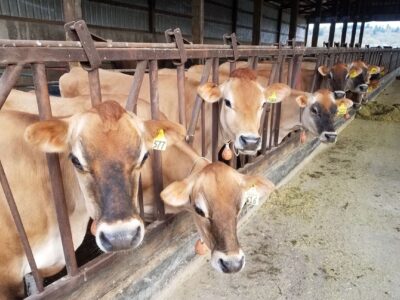



Spent hemp biomass: Study shows it's a feed ingredient that supports milk production in dairy cows
A new study explores whether the plentiful, fibrous byproduct of CBD production holds potential promise as a nutritious, efficiency-boosting feed ingredient for dairyHemp cultivation has exploded in recent years, especially as CBD, a nonpsychoactive cannabinoid, has grown in popularity. As a result, there have been increasing calls—including from the Association of American Feed Control Officers—for CBD’s by-product, spent hemp biomass, to be investigated as a potential animal feed ingredient. Is this plentiful fiber source a reliable, healthy new feedstuff for livestock, including dairy cows?
In the latest issue of the Journal of Dairy Science, an international research team is helping to provide an answer. Their new study—the first of its kind using biomass left over following extraction of CBD—demonstrates that spent hemp biomass is a safe, if somewhat unpalatable, feed ingredient to include in the diets of lactating dairy cows.

Given that the US Food and Drug Administration has yet to approve feeding hemp, or any of its by-products, to livestock, why do we care about spent hemp biomass as a potential food source? The study’s lead investigator, Massimo Bionaz, PhD, of the Department of Animal and Rangeland Sciences, Oregon State University in Corvallis, OR, explained “We know from recent research that spent hemp biomass has very promising nutritional value.” As an ingredient, it’s rich in anti-inflammatory and antioxidant properties that can benefit an animal’s immune system, performance, and overall health.
“It even shows potential in helping us achieve sustainability and efficiency goals, possibly increasing an animal’s nitrogen use efficiency, and reducing methane production,” says Bionaz.
Furthermore, the dairy sector is always seeking out feed options to help benefit the animal, the producer, and the consumer in the face of feed market volatility and fluctuating milk prices—especially when taken from sources that would otherwise be discarded.
While hemp research is ongoing in agriculture, Bionaz and his team are the first to study spent hemp biomass with measurable levels of cannabinoids—a characteristic of the hemp varieties grown for CBD extraction—on the productivity and health of dairy cows.
“As with any feed ingredient, it is critical,” explained Bionaz, “to first understand whether it is safe to be fed to dairy cows and ensure that it does not negatively affect lactation performance or the health of the animals.”
An international team of researchers started their investigation by enrolling 18 late-lactation Jersey cows in their 8-week study. After an initial four days being fed the exact same mid-lactation basal diet, the cows were split into two groups, with one being fed increasing levels of feed supplemented with spent hemp biomass and the control group receiving alfalfa meal—both maxing out at 13% of dry matter. Then the same group of Jerseys had 4 weeks of withdrawal, in which the feed supplements were slowly reduced back down to zero. The team measured the cows’ dry matter intake, body weight and body condition score, milk yield, and milk components and fatty acid profiles throughout the study, along with their blood parameters, nitrogen metabolism, methane emission, and activity levels.
“Our results show that spent hemp biomass is in fact safe as a potential feed ingredient for lactating dairy cows and does not negatively affect lactation performance or the health of the animals,” said Bionaz. “However, we did see a decrease in feed intake for the cows with spent hemp biomass in their diet.”
The team theorized that this low palatability was probably due to some of the novel sensory characteristics of hemp. “Dairy cows are creatures of routine, and are likely not accustomed to the characteristic ‘skunk’ smell from spent hemp biomass, especially in its concentrated pelletized form,” explained Bionaz.
Despite this lower dry matter intake, milk production was unaffected and, surprisingly, even increased compared with the control group after the hemp was withdrawn from the cows’ diets. The team are eager to explore the follow-up questions from their research, including the possibility that dairy cows could adapt to eating spent hemp biomass over time, and exploring whether feeding spent hemp biomass could prime dairy cows for higher efficiency.
“Overall, and in line with our initial hypothesis,” said Bionaz, “feeding spent hemp biomass, even with a relatively high level of cannabinoids, decreases feed intake but does not affect lactation performance or the health of the animals.”
Although Bionaz and the team emphasize the importance of additional research, this initial study provides the critical first evidence that spent hemp biomass might be added to the diet of lactating dairy cows without compromising health and performance of the animals.


